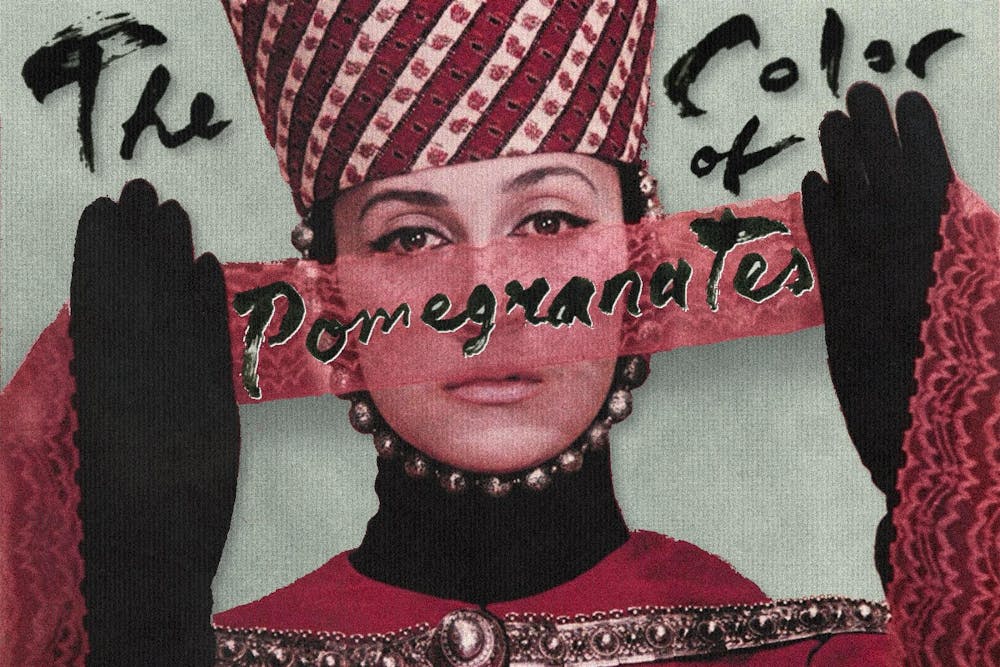“The Color of Pomegranates” is worth watching on a big screen, and you’re in luck, because the Browning Cinema at the DeBartolo Performing Arts Center is showing the picture this Thursday. Still, I have to admit that the first time I watched it was on the tiny, dirty screen of my high school–issued Chromebook, and nevertheless, it was a great watch — that’s a testament to the power of its visuals, I guess.
The screening is part of the “Notre Dame Writers Pick Some Movies for Us to Watch” film series, sponsored by the University’s Creative Writing Program. Presumably the writer who picked this one was a poet, not a screenwriter, because “The Color of Pomegranates” has almost no dialogue.
Based on the poetry of Armenian troubadour Sayat-Nova and inspired by Persian miniature paintings, the film consists of a series of elaborate visuals strung together into a 75-minute collage. You don’t need to know anything about Armenian troubadour Sayat-Nova or Persian miniature painting to get something out of the movie, though. I certainly don’t, but it’s still one of my all-time favorites.
It reminds me a lot of Pier Paolo Pasolini’s “The Decameron” — which was also screened at the Browning last year — and its beautiful “Giotto’s Pupil” interludes, where the director poses his cast into massive Renaissance-inspired paintings. It should be noted, however, that “The Color of Pomegranates” predates “The Decameron” by a couple of years. And, to be honest, Sergei Parajanov (the director of “The Color of Pomegranates”) is a lot better at executing these complex tableaus.
That makes sense, though. The visuals are the bread and butter of “The Color of Pomegranates,” but in “The Decameron,” the focus is on Pasolini’s improvisational way of shooting Italian serfs up to no good — the striking interludes are just an added touch.
Once, I was describing “The Color of Pomegranates” to a friend — all its bleeding fruit, black lace, intricate costumes, bizarre staging and cavernous sets — and he said something like “Sounds like a great movie to watch high!” Reader, that just about threw me into a tizzy! If anything, “The Color of Pomegranates” is a movie that you need to be sober for.
Firstly, all of the ominous Armenian music in the background and the actors enigmatically staring at the audience sound like the perfect recipe for a bad trip. Secondly, there are details in every nook and every cranny of each frame, and you’ll miss it all if you’re sitting there thinking stuff like “My feet feel funny” and “Food hits different when you’re hungry.” If you have to get high, then watch “Click,” but don’t bother with “The Color of Pomegranates” — the movie is its own high, anyway.
I’m no post-structuralist, but I think “There is nothing outside the text” is a pretty good rule of thumb for talking about movies. Who cares about whether production was difficult, what the box office numbers were, who got canceled before or after the release, etc.? Just tell me about whether you liked it or not and why!
When I watch “Color of Pomegranates,” I’m not thinking, “Wow, what a beautiful movie about Armenian culture made in the Soviet Union at a time when Armenian culture was heavily repressed.” No, I’m thinking, “Wow, what a beautiful movie.” Art can be political, sure, but it never stops being art and must be first-and-foremost enjoyed as such — as art.
So maybe Browning’s decision to screen “The Color of Pomegranates” has something to do with the recent eviction of Armenians from their homes in Nagorno-Karabakh by the Azerbaijani government. Maybe it doesn’t. Either way, it’s a great movie — certainly one worth 75 minutes of your time — and that's ultimately what matters.










